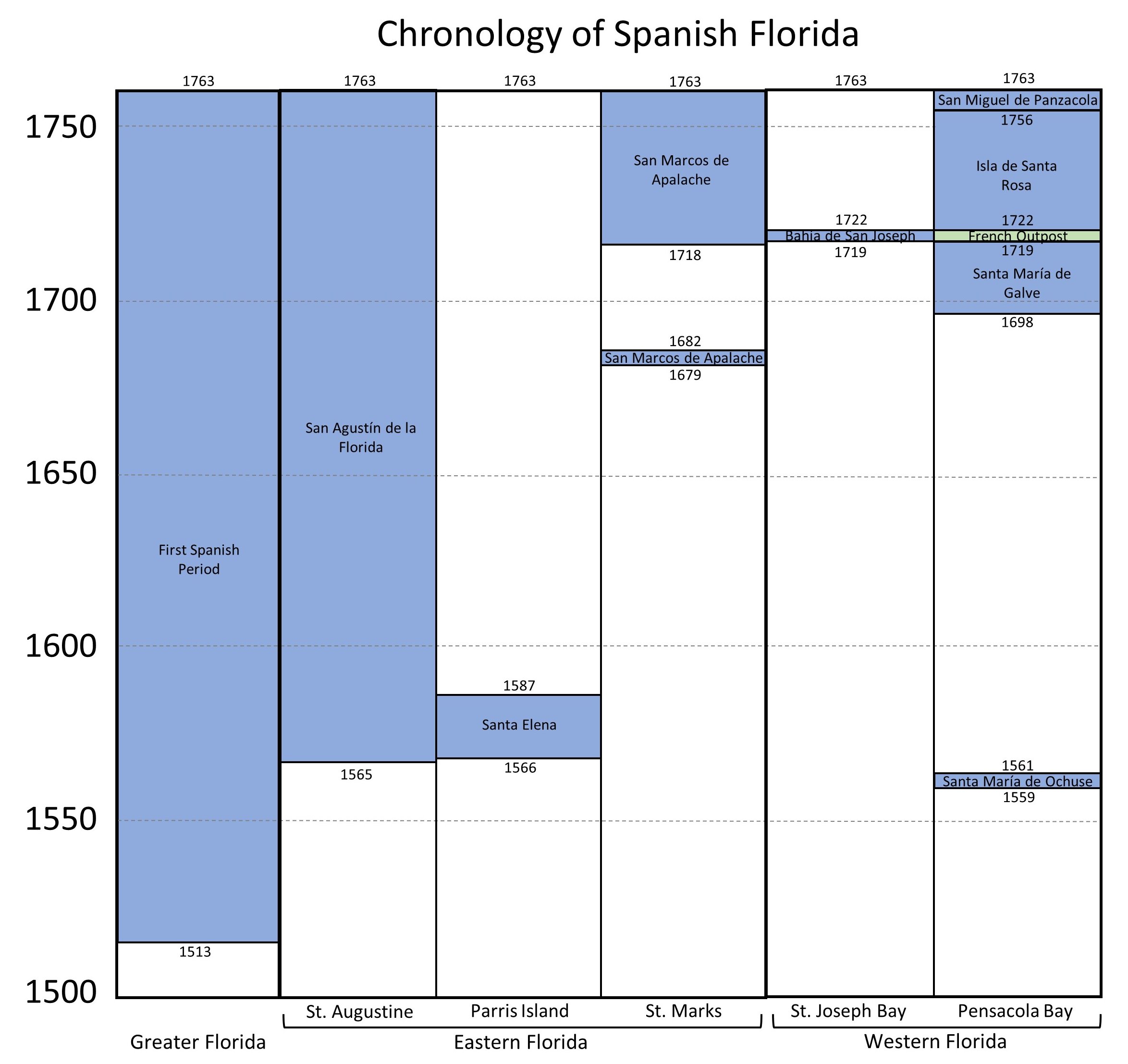Chronology of Spanish Florida
See also: Settlement of Spanish Florida / Florida After 1763
 Broadly conceived, the history of greater Spanish Florida during the First Spanish Period (1513-1763) can be subdivided into four periods, as outlined below:
Broadly conceived, the history of greater Spanish Florida during the First Spanish Period (1513-1763) can be subdivided into four periods, as outlined below:
Exploration, 1513-1565: This era spans the half-century between Florida's original discovery and naming by Juan Ponce de León and the 1565 establishment of the primary hub of all subsequent Spanish colonial activity at St. Augustine. It was an era characterized by sporadic exploratory ventures along the coasts and interior of the Southeastern United States, as well as several short-lived colonial attempts along the Atlantic and Gulf coastlines by both Spanish and French colonists. For more details see the Settlement page.
Initial Colonization and Fortification, 1565-1587: The initial phase of Spanish Florida's true development as a colonial society was marked during the late 1560s by the establishment by Pedro Menéndez de Avilés of not only two coastal port cities along the Atlantic coastline (St. Augustine in 1565 and Santa Elena in 1566), but also the rapid establishment of a far-flung network of garrisoned forts (and some early missions) extending from the Appalachian foothills in present-day western North Carolina to the southern tip of peninsular Florida. While the most of these forts had been overrun or withdrawn by the summer of 1569, their distribution is instructive regarding Menéndez's original vision for the Florida colony, in stark contrast to its eventual configuration during the following century.
The Mission Era, 1587-1706: The primary mission era in Spanish Florida began with the successful distribution of Franciscan missionaries among indigenous coastal populations near St. Augustine and northward, and the eventual expansion of these missions into the interior across peninsular Florida, and to the northern Georgia coastline.. Three eras of expansion and eventual decline can be distinguished, as noted below:
Expansion, 1587-1633: Franciscan expansion began along the Atlantic coastline north of St. Augustine, as well as along the middle St. Johns River west and south of St. Augustine, and eventually pushed into the interior lake and riverine district, and finally to the populous Apalachee province in northwest Florida.
Peak Activity, 1633-1659: During the middle decades of the 17th century, the mission system incorporated populations from major provincessuch as Apalachee, Yustaga, Timucua, Mocama, and Guale, along with other more distant groups along the margins of the primary mission districts. Mission provinces provided a pivotal source of both labor and staple foods for the port city of St. Augustine, though occasional uprisings resulted in some forced resettlement and increasing (though still limited) Spanish military presence in the mission frontier.
Retreat, 1659-1706: Beginning with the arrival of the first English-sponsored Indian slave-raiders in 1659, the last decades of the 17th century were marked by increasingly bold assaults from Erie (Westo/Chichimeco), Yamasee, and Creek Indian attackers, forcing the establishment of formal Spanish garrisons in most provinces, as well as the step-by-step contraction and retreat of mission populations toward accessible waterways and roads. By 1706, the last few hundred surviving inhabitants of the missions had either been withdrawn to St. Augustine, or had fled west to the margins of French territory on the northern Gulf, where the newly-established Pensacola presidio of Santa María de Galve (est. 1698) weathered increasing aggression from these same raiders.
Coastal Contraction, 1706-1763: The final decades of Florida's First Spanish period were characterized by a return to the coastal focus of the colony's initial years. Following the decline of the Indian slave trade after the 1715 Yamasee War, Florida's eastern and western port communities of St. Augustine and Pensacola were augmented only by the coastal fort at San Marcos south of the earlier Apalachee mission province. The interior was increasingly relegated to the Creek Indians, whose initial settlements in the panhandle were later followed by seasonal expansion into the rich hunting grounds of the northern peninsula (these groups later formed the nucleus of the Seminoles). Remnant mission communities adjacent to St. Augustine were supplemented by new missions among Yamasee and Apalachee Indians near Pensacola, but all these groups eventually chose exile with the Spanish in Cuba and Mexico in the aftermath of the Seven Years War (1756-1763), when British forces exchanged the city of Havana for the entire colony of Spanish Florida.
Florida After 1763: When the Spanish finally returned to Florida in the 1780s after some two decades of British occupation, the social and political landscape of the Southeastern United States was in many ways fundamentally different, making Florida of the Second Spanish Period a very different type of colonial society than that described here for Florida's first 250 years.